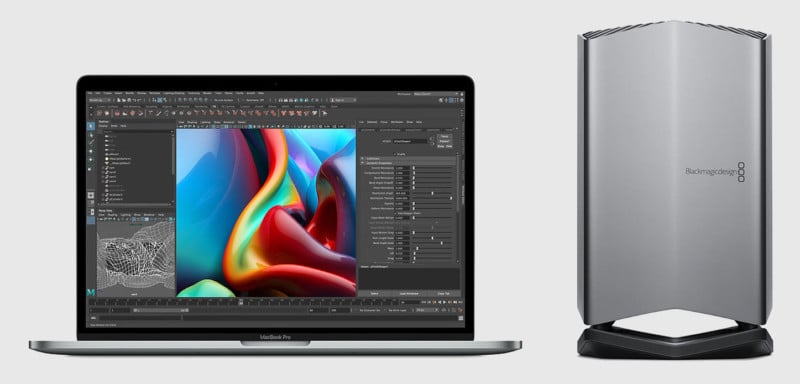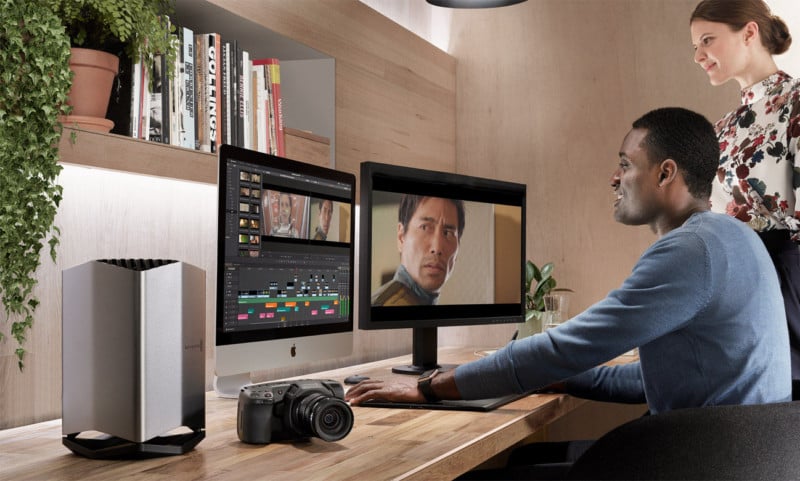Last week, Apple and Blackmagic unveiled a new $699 external GPU (eGPU) that brings “desktop-class” graphics performance to MacBook Pros. But if you were hoping that it would be a godsend for speeding up your sluggish Photoshop or Lightroom for post-processing photos, you may want to check out this new 16-minute review by photoshopCAFE.
Colin Smith got his hands on a Blackmagic eGPU and put it to the test with his 2017 MacBook Pro running Photoshop, Lightroom, and Premiere Pro.

When he tested applying a complex preset to 49 photos, Smith actually found that using the eGPU was actually slower than just simply using his MacBook Pro (14.73 seconds vs 9.78s).
Applying a Radial Blur filter to a massive panorama was slightly (but almost inconsequentially) faster when using the eGPU (27.52 seconds vs 28.34s).
It was the same story with other features tested: there wasn’t much of a speed gain when using the new eGPU.
But there’s a reason for this: your graphics card isn’t actually as important for running Photoshop and Lightroom as other components in your computer, namely the CPU, RAM, and SSD (which is much faster than a traditional HDD).

The Blackmagic eGPU is geared more toward video than still photography.
Adobe has a couple of helpful FAQ pages on how Photoshop and Lightroom leverage a graphics processor. What you’ll find is that there’s a small and limited subset of features that are accelerated by having a better graphics card.
For Photoshop it’s things like Camera Raw (certain functions), Image Size (Preserve Details), Select Focus, Blur Gallery, Smart Sharpen, Perspective Warp, and Select and Mask (OpenCL accelerated).
For Lightroom Classic CC, a GPU will speed up adjusting images in the Develop module, rendering images in Library (Grid, Loupe, and Filmstrip), and working with ultra-high-resolution displays (e.g. 4K and 5K).
But for all the other features and functions of Photoshop and Lightroom, you won’t see any meaningful gains. What’s more, neither Photoshop and Lightroom take advantage of having multiple graphics processors connected, and having multiple GPUs with conflicting drivers can actually cause issues with accelerated features.
“I did mention on my video that I hope to see more support in the future,” Smith tells PetaPixel. “I’m talking with folks at Adobe to get more info on what to expect for the future. At this point, I don’t think it matters ‘whos to blame’ for the lack of support, but more, ‘is this something that will help users of Photoshop and LR Classic right now?'”
So if you’ve been eyeing the shiny $699 Blackmagic eGPU for speeding up your photography work, you may want to spend your money on other hardware upgrades instead. The Blackmagic eGPU wasn’t designed to improve Photoshop and Lightroom for photographers — instead, it’s geared toward professional video programs that are able to take advantage of the eGPU for more core features.
Continue reading...
Colin Smith got his hands on a Blackmagic eGPU and put it to the test with his 2017 MacBook Pro running Photoshop, Lightroom, and Premiere Pro.
When he tested applying a complex preset to 49 photos, Smith actually found that using the eGPU was actually slower than just simply using his MacBook Pro (14.73 seconds vs 9.78s).
Applying a Radial Blur filter to a massive panorama was slightly (but almost inconsequentially) faster when using the eGPU (27.52 seconds vs 28.34s).
It was the same story with other features tested: there wasn’t much of a speed gain when using the new eGPU.
But there’s a reason for this: your graphics card isn’t actually as important for running Photoshop and Lightroom as other components in your computer, namely the CPU, RAM, and SSD (which is much faster than a traditional HDD).
The Blackmagic eGPU is geared more toward video than still photography.
Adobe has a couple of helpful FAQ pages on how Photoshop and Lightroom leverage a graphics processor. What you’ll find is that there’s a small and limited subset of features that are accelerated by having a better graphics card.
For Photoshop it’s things like Camera Raw (certain functions), Image Size (Preserve Details), Select Focus, Blur Gallery, Smart Sharpen, Perspective Warp, and Select and Mask (OpenCL accelerated).
For Lightroom Classic CC, a GPU will speed up adjusting images in the Develop module, rendering images in Library (Grid, Loupe, and Filmstrip), and working with ultra-high-resolution displays (e.g. 4K and 5K).
But for all the other features and functions of Photoshop and Lightroom, you won’t see any meaningful gains. What’s more, neither Photoshop and Lightroom take advantage of having multiple graphics processors connected, and having multiple GPUs with conflicting drivers can actually cause issues with accelerated features.
“I did mention on my video that I hope to see more support in the future,” Smith tells PetaPixel. “I’m talking with folks at Adobe to get more info on what to expect for the future. At this point, I don’t think it matters ‘whos to blame’ for the lack of support, but more, ‘is this something that will help users of Photoshop and LR Classic right now?'”
So if you’ve been eyeing the shiny $699 Blackmagic eGPU for speeding up your photography work, you may want to spend your money on other hardware upgrades instead. The Blackmagic eGPU wasn’t designed to improve Photoshop and Lightroom for photographers — instead, it’s geared toward professional video programs that are able to take advantage of the eGPU for more core features.
Continue reading...


